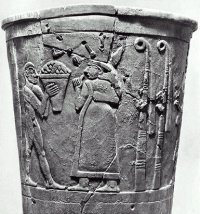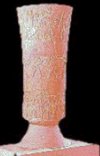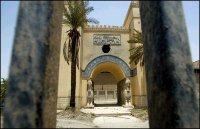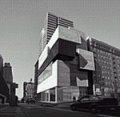Art Pottery, Politics and Food
Saturday, June 14, 2003
In our No Rest for The Weary Department this morning’s Washington Post takes another at bat with the Iraq Museum pitch.

Iruk Vase, detail
The result is a story that is still defensive and coy when it navigates around press errors of fact, unbelievably, still fails to grasp the priceless nature of the missing artifacts on the Middle Eastern antiquities art market and is filled with unsupported assurances:
The losses turned out to be not nearly as widespread as feared. Reports published around the world that 170,000 items were missing -- the sum of the museum's entire collection -- were vastly inaccurate…When the inventory was calculated this week, a total of 33 of the museum's 8,000 most precious vases, statues and jewels were actually gone. Two underground vaults beneath the Central Bank of Iraq were discovered to contain many of the collection's priceless pieces…
It should be noted that the fears referred to here were expressed in those same reports now described as “vastly inaccurate”. Inaccurate reports that none-the-less consistently quote Donny George, director of Iraq's State Board of Antiquities as claiming 33 or so rapidly stolen priceless items all along. Today’s report continues to incorrectly imply that the artifacts removed from under the Iraq Central Bank were thought to have been missing. A reader of May 6th New York Times would know that:
A top British Museum official said yesterday that his Iraqi counterparts told him they had largely emptied display cases at the National Museum in Baghdad months before the start of the Iraq war, storing many of the museum's most precious artifacts in secure "repositories"…The official, John E. Curtis, curator of the Near East Collection at the British Museum, said he believed that American authorities now knew the locations of the artifact repositories…
The primary source for today’s story is identified only as “Coalition spokeswoman Naheed Mehta”. She repeats yesterday’s coincidental return story:
“They said they had some artifacts they wanted to give back. It just so happened that Pietro Cordone was visiting the museum -- he doesn't go every day -- and they handed it to him. He thanked them for it”…"We didn't interrogate them," she said. "We usually don't."
A story in the June 9th edition of the Washington Post said that the Iruk or Warka Vase:
…Had been bolted to a podium… but looters breached the glass case and ripped the vase from its base.
In today’s report Ms. Mehta describes a scene that make the June 9th description “vastly inaccurate”:
She said the vase had been taken not, as previously reported, from its glass case in an exhibition room, but from a restoration room in the back of the museum where experts were working on the piece. "It had been broken in half in antiquity, and had been repaired in the past . . . It was brought back in exactly the same condition it left the museum. It hadn't suffered any more damage," she said.
And, that’s the way it is…ahem…well, at least for now anyway.
Photo: Washington Post

This morning, after days of retro media feeding upon the fatty tissue of Clintonian sexuality, the Washington Post takes tentative steps into the substance of Hillary Clinton’s Living History in a David von Drehle front page story headlined, In Memoir as Manifesto, Clinton Takes On the GOP. In von Drehle’s excerpts Mrs. Clinton is focused on an eccentric cardigan wearing, tiny dog walking fan of Gilbert and Sullivan:
…Clinton sketches an indictment of Chief Justice William H. Rehnquist…Though she does not call for Rehnquist's impeachment, she accuses him of leading a conspiracy to replace a fair-minded special prosecutor with a partisan zealot in the Whitewater investigation…Clinton also accuses Rehnquist of allowing a personal bias against the Clintons to color his legal opinions and of clinging to outdated, racist views…Clinton never makes clear exactly why Rehnquist has such a prominent place on her list of Republicans coldly bent on subverting the Constitution to "topple a President"…But by placing the chief justice neck deep in the cabal trying to oust her husband, Clinton is able, at the end of the book, to link the hotly disputed 2000 presidential election recount to the impeachment attempt of the previous year. In writing of the Supreme Court's 5 to 4 decision to halt the examination of uncounted ballots in Florida -- thus awarding the presidency to George W. Bush -- Clinton adopts the view, widely held on the left, that conservatives on the court, including Rehnquist, simply rigged the result.
Photos: CBS, The Marion Star
Friday, June 13, 2003
Thursday, June 12, 2003
Returned!

Warka or Iruk Vase
From the Friday June 13 issue of ArtDaily.com:
The U.S.-led Coalition Provisional Authority (CPA) has announced that the Vase of Warka, one of the most treasured antiquities looted from Baghdad’s famed museum after the U.S.-led war on Iraq, was safely returned on Thursday.
The vase dates from 3200 BC and was returned by three Iraqis in a car. The Iraqis handed the vase, along with other looted items to the CPA security staff.
The Iraqi men were met by ambassador Pietro Cordone, senior culture adviser to the CPA, who was at the museum when the work was returned. Cordone thanked the men for returning the vase.
According to an AP report posted on the New York Times website at 3:02 PM EDT:
The sacred Vase of Warka...was returned unceremoniously Thursday in the trunk of a car...Three men gave the pieces to security staff at the central Baghdad museum...the men arrived unexpectedly...The [Coalition Provisional] authority did not identify them.
Monday's nutty Washington Post report (see June 9th post) described the vase as being "bolted to a podium...looters breached the glass case and ripped the vase from its base".
It would seem likely that the vase is damaged.
Doesn't it seem a bit odd that three Iraqi drive up, turn the most famous missing Iraqi antiquity out of their car's trunk, present it to a Coalition "senior culture advisor" no less who just happened to be nearby and then discretely exit without being asked pertinant information such as their identities?
Photo: ArtDaily.com

This from novelist William Gibson's blog:
Microscopic analysis of WTC dust by Nicholas Petraco, BS, MS, DABC, FAAFS, FNYMS at The New York Microscopic Society lecture held at AMNH 28 May 2003
45.1% Fiberglass, rock wool (insulation, fireproofing)
31.8% Plaster (gypsum), concrete products (calcium sulfate, selenite, muscodite)
7.1% Charred wood and debris
2.1% Paper fibers
2.1% Mica flakes
2.0% Ceiling tiles (fiberglass component)
2.0% Synthetic fibers
1.4% Glass fragments
1.3% Human remains
1.4% Natural fibers, trace asbestos (it became illegal to use during WTC construction)
Other trace elements: aluminum, paint pigments, blood, hair, glass, wool with resin, and prescription drugs were found.
NOTES:
Particles found were 1-4 micrometers in size. (In general, particles that are 5-8 microns are irritants, and those that are 104 microns are small enough to be airborne and ingested into the lungs.)
Fiberglass particles are smaller than asbestos and lodge deeper into lungs creating more serious long-term health hazards than asbestos like white lung disease which will become more evident 5, 10, 20 years from 11 Sep 2001.
Photo: whatreallyhappened.com
This morning’s New York Times reported 4,000 US soldiers are presently engaged in the largest military operation conducted in Iraq since President Bush declared victory on the deck of the USS Abraham Lincoln.

Operation Peninsula Strike
That field commanders can feel political heat from Washington is reflected in these concluding sentences:
Gauging the intensity of the surge in attacks has been difficult. American military officials disclose the deaths of American soldiers in Iraq but do not routinely publicize every attack on American forces. Military officials declined a request this week to produce figures totaling the number of attacks on Americans forces over the last six weeks. Conversations with soldiers in the area, where the Tigris creates an island of green in a bleak brown desert, suggested that the level of attacks north of Baghdad had been intense. Soldiers said convoys were routinely fired on in the area at night, with bullets striking the first and last vehicles and rocket propelled grenades whizzing over gunners' heads and between jeeps. "We are just lucky they are bad shots," said Staff Sgt. John Williams, who was involved in the operation.
Meanwhile, down the coast at the Washington Post, the plot thickens over the forged Niger uranium documents umbrella’ed into what the Brits are calling, in the fashion of Erle Stanley Gardner, the “Dodgy Dossier”.
Straightforwardly, according to the Independent, the Brits cut to the chase in the annual report of Parliament’s Intelligence and Security Committee:
The report portrays a government willing to spice official intelligence with uncorroborated material, while ministers remain badly informed and "not sufficiently engaged" in the fight against groups such as alQaeda. It maintains that senior ministers did not read all the espionage material available to them, including vital intelligence in tackling weapons of mass destruction.

The Vice President
Was the CIA cart or horse in the murkier American drama and is that Dick Cheney tapping, as of someone gently rapping, rapping at our Langley’s door?
In the inverted, inverted lead so popular with today’s press, the last few graphs of Mr. Pincus’ story bear tantalizing fruit:
The CIA's decision to send an emissary to Niger was triggered by questions raised by an aide to Vice President Cheney during an agency briefing on intelligence circulating about the purported Iraqi efforts to acquire the uranium, according to the senior officials. Cheney's staff was not told at the time that its concerns had been the impetus for a CIA mission and did not learn it occurred or its specific results. Cheney and his staff continued to get intelligence on the matter, but the vice president, unlike other senior administration officials, never mentioned it in a public speech.
Unlike those British ministers, I don’t think anyone, left or right, could begin to imagine our Vice President not reading every word of even the dodgiest dossier presented to him.
Is there - is there balm in Gilead? - tell me - tell me, I implore!'
Photo: Reuter's
Apologies: Edgar Allen Poe
Wednesday, June 11, 2003

Burning Towers
I discovered Michel van Rijn’s Art News web page when searching for information on Middle Eastern antiquities in April. Mr. Van Rijn’s page is a very unusual, interesting, bitchy almost overwhelming web page about art crime…smuggling, stealing, forgery and selling. I surf to his site frequently but I should have looked sooner for 5 days ago he posted:
An American terrorist friendly CEO of a Fortune 500 company is not going to be allowed to get away with MURDER! Because of ongoing investigations I am not at liberty to quote his name YET, don't despair… all will be revealed soon! In the meantime if you guessssss right, you will be sssssssseriously rich.
I will not be deterred; this is the hardest story that I have ever taken on in my life. The implications of exposing a CEO of a Fortune 500 company whose power extends globally and who is a million dollar contributor to the Republican Party means I have major hurdles to jump before me.
The same CEO has also instructed his henchmen, that whatever it takes is within the game, to suppress this devastating information! "Buy them off, buy them all off. Do whatever it takes!"
The city of Baalbeck in Lebanon is the head quarters of the Hezbollah terrorist movement. The operation of any form of business in Baalbeck, legal or illegal, means you're in bed with Hezbollah.
Illegally excavated antiquities are an important financial resource for terrorist organizations giving them easy access to millions of dollars. The buying of antiquities from Baalbeck based dealers is feeding the pockets of the Hezbollah!!!
MvR.com is going to expose an all American CEO who sent in total $3.5 million dollars just before and just after 9/11 to an account of a terrorist related antiquities dealer in Baalbeck.
If you thought sending money before 9/11 to Baalbeck was a crime, what do you call it when it is sent after 9/11???
This is not a 'Martha Stewart'; this calls for the death penalty.
I understand that some astute readers of MvR.com will make a fortune on the company by going short once they put two and two together… Good luck to you all.
As I am cooperating with a Middle Eastern government agency I will disclose in several parts all the devastating information while respecting their investigations.
Yikes! Does van Rijn’s “a million dollar contributor to the Republican Party” connect to the American Council for Cultural Policy?
Reserve some time to immerse yourself in Michel van Rijn’s world. Letters forming his name trailing the mouse cursor presents the only irritant on a terrific site that I will visit again.
Tuesday, June 10, 2003
BLIXED OFF!

Soon to retire UN chief weapons inspector Hans Blix departed from diplomatic language this Wednesday morning during a frank interview with a British newspaper:
Speaking exclusively to the Guardian from his 31st floor office at the UN in New York, Mr Blix said: "I have my detractors in Washington. There are bastards who spread things around, of course, who planted nasty things in the media. Not that I cared very much..."By and large my relations with the US were good," he said. "But towards the end the [Bush] administration leaned on us...there are people in this administration who say they don't care if the UN sinks under the East river, and other crude things".
Photo: BBC

Persistent attacks against U.S. forces in Iraq could be the result of an organized guerrilla movement led by Baath Party loyalists, Defense Secretary Donald H. Rumsfeld said today. "There are some who would say that in certain parts of the country, it looks as though it has an element of organization to it, as opposed to being random," Rumsfeld told reporters.
The Washington Post
Photo: Modified picture of Hamas recruits, Reuter's
Monday, June 09, 2003
Yesterday I posted about the growing difference in meaning between headline and story in many American newspapers these days.

Iraq National Museum
Today the Washington Post presents another story about the Iraq National Museum, under the headline All Along, Most Iraqi Relics Were ‘Safe and Sound’, that seems to be correcting “facts” from yesterday’s Iraq Museum dispatch while peddling a story heavy with disingenuous bluster:
The world was appalled. One archaeologist described the looting of Iraq's National Museum of Antiquities as "a rape of civilization."…Condemnation rained down on U.S. military commanders and officials in Washington for failing to stop the pillage of priceless art, while tanks stood guard at the Ministry of Oil. It was as if the coalition forces had won the war, but lost an important part of the peace and history. Apparently, it was not that bad.
I cannot for one moment imagine what reporters William Booth and Guy Gugliotta mean by “not that bad”.
The gold and ivory Treasures of Nimrud that were recovered from the vaults under the bombed Iraq Central Bank have been submerged for months in sewage!
Would William and Guy find the bombing and submersion of vaults containing some of their most valuable possessions "not that bad?"
Additionally these items and others, first mentioned by a top British Museum official quoted in the New York Times on May 6, were never included in anyone’s estimate of missing antiquities as they were never considered missing by the Museum staff and other world experts as they were either inaccessible or in the hidden vaults.
Hidden bombed vaults under the Iraq Central Bank as well as a perimeter of hidden vaults around the Iraq Museum itself:
"I said there were 170,000 pieces in the entire museum collection," said Donny George…"Not 170,000 pieces stolen." George, the director general of research and study of the Iraqi State Board of Antiquities and the source for the original number, said the theft of 170,000 pieces would have been almost impossible: "No, no, no. That would be every single object we have!"…George is a respected and internationally known archaeologist and administrator. He apologized for the confusion, which has caused anguish among Mesopotamia scholars and the general public alike, but essentially said it was not his fault. George conceded that during the 48 hours when his museum was being looted, he was extremely upset with the Americans.
.jpg)
The White Lady, 3,500BC
As framed by what I’ve read in the confused American press, the differences in this story have mostly been cultural with a large measure of American self-consciousness over the historic and cultural atrocity of the looting itself along with an odd refusal to distinguish between high value and the run of the mill historic artifacts. Mr. George has been remarkably consistent throughout the turmoil regarding the 33 plus priceless items that were promptly taken by glasscutter wielding “Westerners” as Baghdad fell to US forces.
Were culturally and politically connected people in place in Baghdad with access to swift cargo transport out of country? I don’t know.
On April 19th the head of UNESCO told the Washington Post that well-organized professional thieves stole most of the priceless artifacts looted from Baghdad's National Museum of Antiquities. On April 22 Melbourne,Australia’s theage.com.au reported:
Art collectors and dealers say they are already getting queries about artifacts looted from Iraq's museums, and the FBI said today at least one suspected piece had been seized at an American airport.
.jpg)
Iruk Vase, detail, 3,000BC
A very few members of the world’s press have explored this interesting avenue of investigation. Does it seem too difficult a task for prompt consideration by the media of a powerful occupying power?
As John Ashcroft told an Interpol conference in Lyons, France May 6th, “Criminal gangs were likely behind the looting of historical treasures during the war in Iraq.”
I have seen very few references or descriptions of membership, in the American press, to a group of art traders, calling itself the American Council for Cultural Policy (ACCP) that met, according to several European newspapers, in Washington on January 24, 2003 with senior Pentagon and State Department officials to discuss liberalizing “Iraq’s retentionist antiquities policy”.
Liam McDougall, an arts columnist for Scotland’s Sunday Herald said, "among [the ACCP’s] main members are collectors and lawyers with checkered histories in collecting valuable artifacts, including alleged exhibitions of Nazi loot."
It would be very interesting to discover any links between ACCP and the interests of Ahmed Chalabi.
President Bush could have taken the investigative lead by asking good friend Sheikh Saud al-Thani of Qatar about the Middle Eastern antiquities market that he dominates during his mid May White House visit. Reporting a May 6 Sotheby’s of London auction of Middle Eastern antiquities TheArtNewspaper.com said:
Sheikh al-Thani was assumed to be the anonymous telephone bidder who paid £1.12 million ($1.79 million) for an exquisite 13th-century Persian pencase, and £901,250 for a Hispano-Mauresque gilt-bronze fountainhead in the form of a cockerel...
.jpg)
Bronze bust of an Akkadian King,
2,300BC
I have not read any account of damage to the ancient objects from the Iraq Museum except for the last paragraph of an AP report carried on the New York Times website on May 7th that said the Golden Harp of Ur was found in pieces laying with other debris on the Museum floor. This possession of an ancient princess is, or was, a 4,000 year-old wooden harp inlayed with gold, precious stones and shell. How does one recover the tiny bits of inlay that were scattered with the broken rubble on the Museum floor? It seems as impossible as resurrecting an unknown and untranslated ancient poem once inscribed onto a cuneiform tablet now crumbled to dust. Value is in the eye of the beholder.
What is or isn’t valuable, what is or isn’t damaged and how to explain the difference to someone who only sees only the gold and not the sculpture or jewelry it forms?
Someone is clearly uncomfortable to promulgate, for the second day in a row, a story as mendacious as this one in today's Washington Post no matter how the copy is larded with America’s Roman Imperial security blanket of numbers.
As we partly mentioned yesterday any discussion of overall numbers of missing is problematic as the Iraqi had diverse and inconsistent accounting systems that were almost completely destroyed by the mass looting.
I cannot believe the Pentagon and State Department are occupied with people as obtuse as press accounts on this matter since mid April would have one believe.
Something happened to the Iruk Vase, the White Lady and 30 or so other priceless items from humanity’s common past.
Today’s Post said the vase “had been bolted to a podium… but looters breached the glass case and ripped the vase from its base.”
Who are the wealthy men that committed this brutal act of cultural rape and where are the missing objects now?
How can our great and good United States of America countenance the nonsense we have observed in in the media regarding this theft and recovery?
Here is the lead paragraph that wasn’t in today’s Washington Post:
The 33 to 38 priceless items mysteriously stolen from the Iraq National Museum as Baghdad fell are still missing. Investigators have no suspects or leads.
I have several posts on this topic that begin April 14th. I wish I were blog savvy enough to link them. Yeah and if pigs could fly I’d have a linkable email address in that embarrassingly empty right margin email box. Any format language tips will be gratefully attempted!
Photos: Jamal Saidi-Reuters, TheArtNewsPaper.com
Sunday, June 08, 2003
Journalists have got to stop
these witless disproportionate witch-hunts!
--Joe Klein, ABC ThisWeek

Trial of Geo Jacobs, 1692
Yes, yes, I grimly sat through portions of whatever it is Disney calls the program that, mercifully now, no longer includes Sam or Cokie. Aside from Mr. Will’s innate petulance, Klein’s remark is the only ABC program remnant to linger.
Having other things to do, I failed to catch the National Security Advisor’s appearance on Meet the Press but did manage to watch her high wire unicycle act before the sad basset hound eyes of 41’s old friend Bob Schieffer. While almost dazzled by Condi’s brilliantly white outfit I retained enough of my faculties to be reminded of her “non traditional hijacking” post 911 press conference. Then as now Condi’s eyes seem to have a life and outlook separate from the rest of her body and the evolving logic of her speech. Earlier this week I hopefully cast an amused allegorical eye at Dr Rice as a Cleopatra. This afternoon I am leaning more toward late play Lady MacBeth.
Many have written about a lack of connection between the thrust of some newspaper headlines and the content of the stories they claim to represent. Very early this morning I noticed a headline, In Game of Low Expectations, Bush Usually Wins. I, then, read the Washington Post A Section story. Next, I went to a story about the Iraq National Museum that held more personal interest. Going back now to write about the curious Museum article I noticed the headline had changed on the Bush story. It now reads, In Game of Expectations, Bush Usually Wins, and I would ask any Washington Post Copy Desk Editor to please explain the modified headline’s meaning much less if it relates to the companion story.

The Post story about the Iraq National Museum is, as I said, curious. To my mind it is the first reference to the looting in the media since a press conference from the Baghdad Museum was televised on May 16th.
In the days following the initial breathless looting reports, and if we are discovering anything it is that the Iraqi do everything breathlessly, we have learned that the bulk of missing material while historically valuable really held very little economic value.
We learned that 37 of the most valuable were still missing.
Except for the 4,500-year-old Golden Harp of Ur found broken on the Museum floor, we learned that these missing 37 items were the ones taken promptly by Westerners using western tools.
We learned, from Iraqi shortly after the statue’s fall, that the bulk of the gold objects from the Iraq Museum, usually referred to as the Treasures of Nimrud, were sealed in flooded vaults under the bombed Iraq Central Bank.
And, we learned that the Museum’s records were meager, mostly paper, almost totally destroyed and that they, and the missing objects, were “salvageable” but beyond complete recovery.
This morning, under a headline that could have been written a month ago, Most Iraq Treasures Recovered, I read a story filled more with justification than fact and a Bushian insistence on “numbers”:
Reports describing the looting of Iraq's archaeological treasures from the national museum were exaggerated, and most of the precious inscribed tablets, gold jewelry and artwork dating from the birth of civilization have been recovered, a team of U.S. investigators said today…U.S. officials…now say 3,000 pieces remain unaccounted for and may have disappeared into the shadowy world of black market antiquities trading…More importantly, of the 8,000 items considered the most precious by archaeologists, only 47 are still missing…The investigation was led by U.S. Customs Service agents and State Department officials. Iraqi archaeologists and museum administrators could not be reached for comment on the report or to verify the number of recovered and missing items cited by the Americans.
Suddenly, deep in the story, I spot part of what could have been the lead paragraph:
At the Iraqi Central Bank, the investigators and their Iraqi counterparts spent almost two weeks pumping water out of the basement to reveal the inundated vault of Mesopotamian antiquities. Inside, the team found 179 boxes containing most of the exhibit-quality collection of the national museum, including the Treasures of Nimrud, an ancient Assyrian city near present-day Mosul in northern Iraq.
From my read of older news reports the gold objects under the Central Bank were never considered missing just not easily recoverable and possibly damaged.

This week, the New York Times raves about the new Contemporary Art Center in downtown Cincinnati:
Architectural and urban history were made here recently with the opening of Zaha Hadid's first American building…a work of international stature that confidently meets the high expectations aroused by this prodigiously gifted architect…the Rosenthal Center is the most important American building to be completed since the end of the cold war.
Herbert Muschamp does a terrific job explaining Hadid’s concept and fitting its realization into an artistic and urban context. Best of all, the headline, Zaha Hadid’s Urban Mothership, actually describes the story. Go figure!
Painting: TH Matteson,1855
People ought to get some good art in this country...
Why waste a nickel of it on dogs walking on flags?
--TV Pundit Chris Matthews

Rene Magritte, Attempting the
Impossible, 1929
Photo: Orazio Centaro's Art Images on the Web

